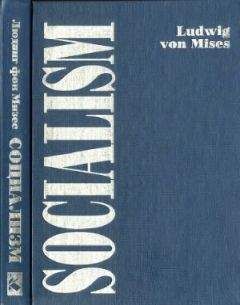Лестер Туроу - Будущее капитализма

Скачивание начинается... Если скачивание не началось автоматически, пожалуйста нажмите на эту ссылку.
Жалоба
Напишите нам, и мы в срочном порядке примем меры.
Описание книги "Будущее капитализма"
Описание и краткое содержание "Будущее капитализма" читать бесплатно онлайн.
Один из ведущих американских экономистов детально анализирует ближайшие и отдельные последствия фундаментальных социально-экономических сдвигов конца XX века: распада коммунистической системы и перемен в странах бывшего социалистического лагеря; развития интеллектуальных технологий; радикального изменения демографической картины мира и др.
В книге даётся анализ глобальной экономики и её движущих сил.
56. Alam Peyrefitte, The Immobile Empire (New York: Knopf, 1992), p. 420; Braudel, History of Civilization, p. 168.
57. Robert J. Thomas, What Machines Can't Do: Politics and Technology in the Industrial Enterprise (Berkeley: University of California Press, 1994), pp. xiv, 6, 10.
1. U. S. Bureau of the Census, Money Income of Households, Families and Persons in the United States 1992, Current Population Reports, Consumer Income, Series P-60-184 (Washington, D. C.: U. S. Government Printing Office, 1993), p. 176.
2. Claudia Goldin and Robert A. Margo, «The Great Compression: The Wage Structure of the United States at Mid-Century,» The Quarterly Journal of Economics, February 1994, p. 4.
3. U. S. Bureau of the Census, Current Population Reports, Consumer Income, 1992, Series P-60 (Washington, D. C.: U. S. Government Printing Office, 1993), pp. xvi, xvii, 14; Sheldon Danziger and Peter Gottschalk, eds., Uneven Tides (New York: Russell Sage Foundation, 1993), p. 7.
4. Daniel R. Feenberg and James M. Poterba, Income Inequality and the Incomes of Very High Income Taxpayers, NBER Working Paper No. 4229, December 1992, p. 31.
5. Ibid., p. 5.
6. Margaret M. Blair, «CEO Pay: Why Such a Contentious Issue?» The Brookings Review, Winter 1994, p. 23; Nancy I. Rose, «Executive Compensation,» NBER Reporter, Winter 1994-95, p. 11.
7. «Nice Work,» The Economist, December 10, 1994, p. 67.
8. Robert H. Frank, Talent and the Winner-Take-All Society," The American Prospect, Spring 1994, p. 99.
9. Peter Kilborn, «More Women Take Low Wage Jobs Just So Their Families Can Get By,» New York Times, March 13, 1994, pp. 16, 24.
10. U. S. Bureau of the Census, Current Population Reports, Consumer Income, 1992. p. B-6.
11. Ibid., p. 21.
12. Lynn A. Karoly, «Changes in the Distribution of Individual Earnings in the United States, 1967–1986,» Review of Economics and Statistics, February 1992, pp. 107, A 78; Danziger and Peter, eds., Uneven Tides, pp.69, 85, 102, 129; Steven J. Davis, Cross-Country Patterns of Changes in Relative Wages, Brookings Papers on Economic Activity, p. 273; Karoly, «Changes in the Distribution of Individual Earnings,» pp. 107, 113; Frank Levy and Richard J. Murnane, «U. S. Earnings Levels and Earnings Inequality,» Journal of Economic Literature, September 1992, p. 1333.
13. «Wealth: The Divided States of America,» New York Times, April 23, 1995, p. F2; Steven Sass, «Passing the Buck,» Regional Review, Boston Federal Reserve Bank, Summer 1995, p. 16.
14. Barry Bluestone, Economic Inequality and the Macro-Structuralist Debate. Eastern Economics Association Meetings, February 1994, p. 8; Lynn A. Karoly, «The Trend in Inequality Among Families, Individuals, and Workers in the United States,» Rand Corporation, 1992, pp. 44, 66, A16, 221; Lawrence Mishel and Ja-red Bernstein, The State of Working America 1992–1993 (Washington, D. C.: Economic Policy Institute/M. E. Sharpe, 1993), p. 14; «Male Educated in a Pay Bind,» New York Times, February 11, 1994, p. Dl; Richard D. Reeves, «Cheer Up, Downsizing Is Good for Some,» International Herald Tribune, December 29, 1994, p. 4.
15. U. S. Bureau of the Census, Income, Poverty, and Valuation of Noncash Benefits: 1993. Current Population Reports, Consumer Income, Series P-60-188 (Washing-
ton, D. C.: U. S. Government Printing Office, 1995), p. x; Council of Economic Advisers, Economic Report of the President 1995 (Washington D. C.: U. S. Government Printing Office, 1995), pp. 276, 311.
16. Economic Report of the President 1995, p. 310.
17. Kevin Phillips, Boiling Point: The Decline of Middle Class Prosperity (New York: Random House, 1993), p. xvii.
18. Keith Bradsher, «American Real Wages Fell 2.3 Percent in 12-Month Period,» New York Times, June 23, 1995, p. D4.
19. Mishel and Bernstein, The State of Working America 1992–1993, p. 36.
20. Jason DeParle, «Sharp Increase Along the Borders of Poverty,» New York Times, March 31, 1994, p. A18.
21. Center for National Policy, Job Quality Index, November 15, 1993.
22. David E. Bloom and Richard B. Freeman, The Fall of Private Pension Coverage in the United States," American Economic Review, May 1992, p. 539; Virgina L. DuRivage, ed., New Policies for the Parttime and Contingent Work Force (New York: Economic Policy Institute/M. E. Sharpe, 1992), p. 22.
23. The Urban Institute, Inequality of Earnings and Benefits, Winter/Spring, 1994, p. 21.
24. «The Widening Pension Gap,» Fortune, March 16, 1995, p. 48; Bloom and Freeman, «The Fall of Private Pension Coverage in the United States,» p. 540.
25. Karoly, The Trend in Inequality," pp. 44, 66, A16, 221.
26. Steven Greenhouse, «Clinton Seeks to Narrow a Growing Wage Gap,» New York Times, December 13, 1993, p. Dl.
27. U. S. Bureau of the Census, Current Population Reports, Consumer Income, 1993,
p. x.
28. Council of Economic Advisers, Economic Report of the President 1995 (Washington, D. C.: U. S. Government Printing Office), pp. 276, 311, 326.
29. Ibid., pp. 276, 326.
30. Kilborn, «More Women Take Low Wage Jobs,» p. 24; Wallace C. Peterson, Silent Depression (New York: W. W. Norton, 1994).
31. Keith Bradsher, «Sluggish Income Figures Show Gains for Some,» New York Times, October 6, 1995, p. A22.
32. U. S. Bureau of Census, Current Population Reports, Consumer Income, 1993, p. x.
33. Mishel and Bernstein, The State of Working America 1992–1993, p. 72.
34. Tamar Lewin, «Mom Is Providing More Income,» International Herald Tribune, May 12, 1995, p. 14.
35. Danziger and Gottschalk, eds., Uneven Tides, p. 195.
36. «Getting Their Dues,» The Economist, March 25, 1995, p. 86.
37. Stephen S. Roach, «Announced Staff Cuts of U. S. Corporations,» in Morgan Stanley Special Economic Study, The Perils of America's Productivity-Led Recovery, 1994.
38. George Church, «The White Collar Layoffs That We're Seeing Are Permanent and Structural,» Time, November 22, 1993, p. 35.
39. U. S. Department of Labor, Employment and Earnings, January 1981 and January 1982, pp. 36, 20.
40. Ibid., pp. 28, 29.
41. Richard E. Caves and Matthew B. Krepps, Fat: The Displacement of Nonproduction Workers from U. S. Manufacturing Industries, The Brookings Papers on Economic Activity, No. 2, 1993, p. 231.
42. John A. Byme, The Pain of Downsizing," Business Week, May 9, 1994, p. 61; Matt Murry, «Amid Record Profits Companies Continue to Lay Off Employees,» Wall Street Journal, Europe, May 8, 1995, p. 1.
43. Farrell Kramer, «AT amp;T and Sprint Plan Big Job Cuts,» Boston Globe, November 16, 1995, p. 46.
44. Dean Baker and Lawrence Mishel, Profits Up, Wages Down, Economic Policy Institute Briefing Paper (Washington, D. C.: 1995), p. 1.
45. Caves and Krepps, «Fat,» p. 227.
46. Martin Neil Baily, Eric J. Bartelsman, and John Haltiwanger, Downsizing and Productivity Growth: Myth or Reality, National Bureau of Economic Research Working Paper No. 4741, May 1994.
47. Martin Orth and Rudiger Edelmann, «Flexible Working Times: Only a Trendy Concept?» Deutschland, No. 1, February 1994.
48. «Deutsche Bank Plan to Cut 10,000 Jobs,» New York Times, September 18, 1995, p. C2.
49. German Information Center, Unemployment in Germany, March 1994.
50. Marlise Simons, «In French Factory Town, Culprit Is Automation,» New York Times, May 12, 1994, p. A3.
51. Mishel and Bernstein, The State of Working America, p. 174; Robert E. Scott and Thea M. Lee, Reconsidering the Benefits and Costs of Trade Protection, Economic Policy Institute Working Paper No. 105, April 1991, p. 41.
52. William J. Carrington, «Wage Losses for Displaced Workers: Is It Really the Firm That Matters?» Journal of Human Resources, Summer 1993, p. 454.
53. Church, «White Collar Layoffs,» p. 35.
54. Bruce Butterfield, «Working but Worried,» Boston Globe, October 10, 1993, p. 1.
55. «Companies Rewrite the Rules on Jobs,» Financial Times, January 7, 1995, p. 12.
56. Bennett Harrison, Lean and Mean (New York: Basic Books, 1994), p. 201; Polly Callaghan and Heidi Hartmann, Contingent Work (Washington, D. C.: Economic Policy Institute, 1994).
57. DuRivage, ed., New Policies, p. 56.
58. Ibid., pp. 3, 21, 22.
59. Jason DeParle, «Report to Clinton Sees Vast Extent of Homelessness,» New York Times, February 17, 1994, p. 1; Christopher Jencks, «The Homeless,» New York Review of Books, April 21, 1994, p. 20.
60. «Europe and the Underclass,» The Economist, July 30, 1994, p. 19.
61. «Homeless in France,» International Herald Tribune, December 20, 1994, p. 1.
62. Sylvia Nasar, «More Men in Prime of Life Spend Less Time Working,» New York Times, December 1, 1994, p. 1.
63. Alan Cowell, «Where Juliet Pined Youths Now Kill,» New York Times, March 22, 1994, p. A4.
64. Nasar, «More Men in Prime of Life,» p. 1.
65. Jencks, «The Homeless,» p. 23; Robert N. Bellah et al., The Good Society (New York: Knopf, 1991), p. 4.
66. A. M. Rosenthal, «Just Walking Past the Broken People,» New York Times, January 18, 1995, p. 4.
67. Цит. по: Peter S. Canellos, «The Outer Class,» Boston Globe, February 6, 1994.
68. Tamar Lewin, «Families in Upheaval Worldwide,» International Herald Tribune, May 31, 1995, p. 1.
69. Tamar Lewin, «Family Decay Global, Study Says,» New York Times, May 30, 1995, p. A5.
70. Urban Institute, Welfare Reform Brief No. 13, p. 3 as corrected.
71. «The Family: Home Sweet Home,» The Economist, September 9, 1995, p. 26.
72. Seth Faison, «In China, Rapid Social Changes Bring a Surge in Divorce Rate,» New York Times, August 22, 1995, p. 1.
73. Steven A. Holmes, «Low-Wage Fathers and the Welfare Debate,» New York Times, April 25, 1995, p. A12.
74. Duncan Lindsey, The Welfare of Children (New York: Oxford University Press, 1994), p. 69.
75. Robert N. Bellah et al., The Good Society (New York: Knopf, 1991), p. 46.
76. Bob Tyrrell and Charlotte Cornish, «Beggar Your Neighbor,» Financial Times, November 17, 1993, p. 14.
77. David Popenoe, «The Family Condition of America,» in Values and Public Policy, ed. Henry J. Aaron, Thomas E. Mann, Timothy Taylor (Washington, D. C.: Brookings Institution, 1994), p. 104.
78. Ibid.
79. Ibid., p. 46.
80. Ibid., p. 73.
81. «The Family: Home Sweet Home,» p. 26.
82. Faison, «In China, Rapid Social Changes,» p. 1.
83. James Q. Wilson, «Culture, Incentives, and the Underclass,» in Values and Public Policy, p. 46.
84. Fred Block, Post-Industrial Possibilities: A Critique of Economic Discourse (Berkeley: University of California Press, 1990), p. 27.
85. «Upon the States' Shoulders Be It,» The Economist, March 25, 1995, p. 67.
86. «The Future Surveyed,» The Economist, September 11, 1993, special section.
87. James Q. Wilson, «The 1994 Wriston Lecture,» The Manhattan Institute, November 1994.
88. Gunnar Myrdal, Against the Stream (New York: Pantheon Books, 1972), p. 175.
89. Peter Drier and John Atlas, «Housing Policies Moment of Truth,» Challenge, Summer 1995, pp. 8, 70.
90. Jack Beatty, «Who Speaks for the Middle Class?» The Atlantic, May 1994, p. 73; Wallace C. Peterson, Silent Depression (New York: W. W. Norton, 1994), p. 53.
Подписывайтесь на наши страницы в социальных сетях.
Будьте в курсе последних книжных новинок, комментируйте, обсуждайте. Мы ждём Вас!
Похожие книги на "Будущее капитализма"
Книги похожие на "Будущее капитализма" читать онлайн или скачать бесплатно полные версии.
Мы рекомендуем Вам зарегистрироваться либо войти на сайт под своим именем.
Отзывы о "Лестер Туроу - Будущее капитализма"
Отзывы читателей о книге "Будущее капитализма", комментарии и мнения людей о произведении.

























